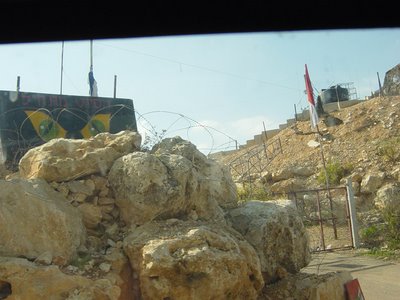

Ebbene si sono arrivato dove volevo in Cisgiordania: il soldato Fantone è andato in missione ed è tornato sano e salvo. Grazie anche agli angeli custodi di Tsahal. E' stata una bella avventura con l'ONG Peace Now. Trovarsi davanti ad uno dei confini internazionali più caldi è stato emozionante: da una parte gli avamposti israeliane e dall'altra i minareti con i muezzin che cantavano. Un contrasto molto forte...
Per il resto abbiamo visitato alcuni avamposti e insediamenti israeliani, limitandoci a guardare la città palestinese di Nablus dall'alto.. sigh
Il paesaggio benchè brullo è fantastio un mix fra la Sicilia e il Carso. Il sole picchia sempre forte meno male che sulle alture soffi un bel venticello che porta un po' di refrigerio. C'è una tranquillità completa rotta solo dal rumore dei veicoli militari (poche sono le auto civili) e dai canti dei muezzin.
Vi metto anche un'immagine della barriera, forse a vederlo così il filo spinato non rende molto però osservare quei due metri e mezzo che dividono la Terra Santa fanno impressione soprattutto quando vedi che sopra un altura c'è un bunker israeliano con una mitragliatrice puntata sull'area.

 During the War of Independence, the Syrian army reached the gates of Degania Alef, but was bravely repulsed. A burnt Syrian tank remains on the site as a memorial. The two Deganias have a combined population of nearly 1,000. Due to the hot climate and abundance of water, both Deganias are engaged in fully irrigated farming. Degania Bet has also a metal factory
and Kadish Luz were members of Degania Bet. A.D. Gordon, Arthur Ruppin, Otto Warburg and other founders of the labor settlement movement are buried on Degania Alef.
During the War of Independence, the Syrian army reached the gates of Degania Alef, but was bravely repulsed. A burnt Syrian tank remains on the site as a memorial. The two Deganias have a combined population of nearly 1,000. Due to the hot climate and abundance of water, both Deganias are engaged in fully irrigated farming. Degania Bet has also a metal factory
and Kadish Luz were members of Degania Bet. A.D. Gordon, Arthur Ruppin, Otto Warburg and other founders of the labor settlement movement are buried on Degania Alef.
1 commento:
e poi i springbocks che c'entrano? ;-). Saluti da Parigi,
U Napoletano falso
Posta un commento